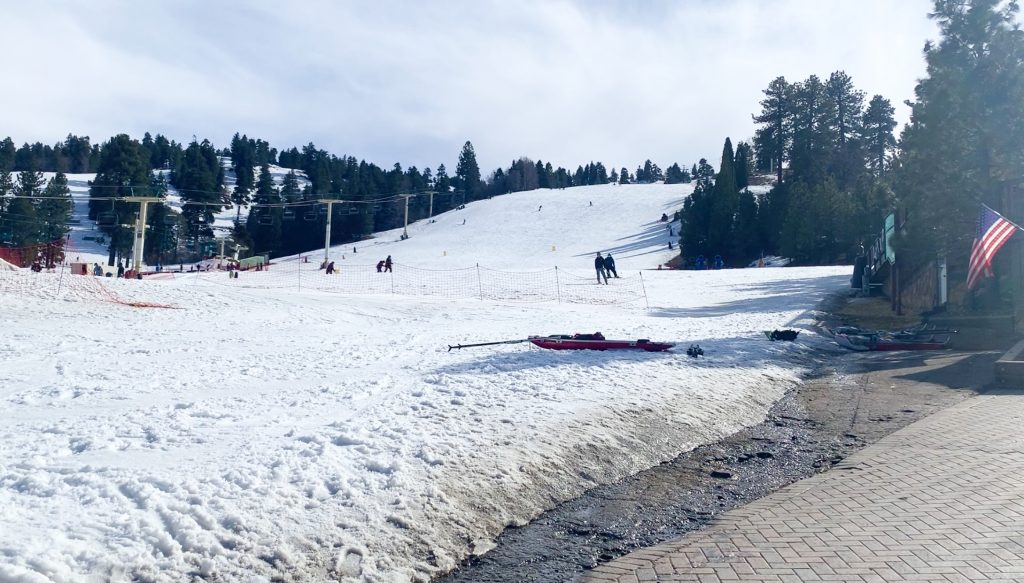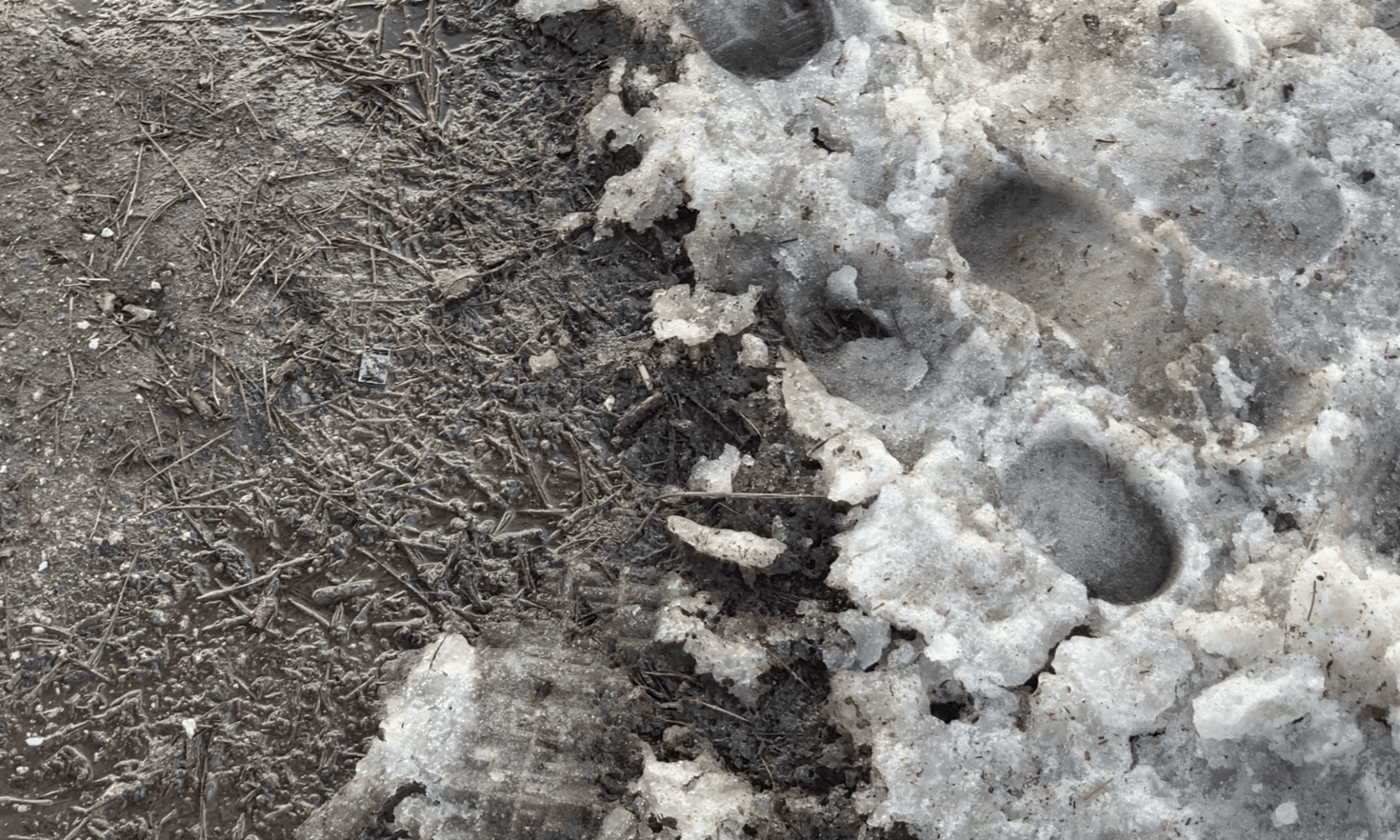The small city of Big Bear Lake sits at an elevation of 7,000 feet, surrounded by the majestic San Bernardino Mountains of Southern California. In the heart of the town is the Village, a Swiss-style strip of quirky shops. At the peak of the winter season, the streets of the Village are flooded with shoppers, musicians, and skiers coming off the mountain. However, for Big Bear, if the snow doesn’t come, the visitors stay home, the skiers go elsewhere, and suddenly the streets of the Village are empty.
Throughout the last 40 years, the global warming trend has meant shorter seasons, less snowpack, and receding snow lines, according to research recently published by the American Geophysical Union. And for smaller mountain towns like Big Bear, one bad snow season can devastate the local economy.
“The ski shops, the restaurants, the hotels… we suffer. This last winter, [2018-2019] everybody was happy, for sure. But the winter before, nobody wants to ski on manmade snow, its a terrible condition, but that’s all we had,” says longtime resident Rick Jeffery, “We had to make do with what we had.”
Jeffery is a naturalist at the Big Bear Discovery Center and has devoted the last 40 years of his life to understanding our environment and how we interact with it. As a Big Bear native, he’s observed the effects of climate change become evident on the mountain over time. Now, Big Bear locals and business owners are scrambling to adapt to the whiplash weather conditions.
Many businesses, like grocery stores, typically plan for winters to be the busiest time of the year. “When I worked in a grocery store, hours were cut. I mean times that were supposed to be really poppin’ and busy… they were dead.” says Summer Gathright, now a guide at the Big Bear Activity Center, “The mountains probably make the most money during the winter. […] So I think without the snow and without the lake, Big Bear could just not be a winter resort anymore.”
In the golden age of skiing during the 1960s and 1970s, snow was dependable at Big Bear’s Snow Summit resort. However, in recent years, mercurial snow seasons have left the small town struggling to maintain a stable economy. The 2013-2014 snow season was one of the lowest on record for Big Bear with only 26 inches. Three years later, in 2016-2017, the mountain received 180 inches of snow—the town’s greatest snowfall on record. The next year, they saw only 36 inches, and with 79 inches in 2019-2020, this last year was about average.
Unfortunately, California is warming at an alarming rate—nearly 2 degrees since 1950—and 2016 was the hottest year on record. Scientists predict temperatures could rise by nearly 9 degrees by 2100 if emissions continue on their current track. This means the length of winter is expected to decline at ski areas across the country, in some areas by more than 50 percent by 2050 and 80 percent by 2090, according to a 2017 report in Global Environmental Change.
To mitigate the economic damage after a bad snow season, Big Bear, like other smaller mountain resorts, has launched a multitude of warm-weather activities for locals and visitors to enjoy in the off-season.
“When we don’t have snow and the mountains can’t produce snow, it really hurts our economy and we definitely see a big decrease in kind of the overall wellbeing of the community,” says Joe Hutchison, property manager at vacation rental property ‘The Club at Big Bear Village’, “so to make up for that loss of revenue, we do a lot of different car shows, music events, and stuff like that.”
As the director of marketing at the Big Bear Visitors Center, Eddie Kirsch explains how important it is for businesses to start attracting year-round visitors.
“There’s a lot of independent business owners who have an idea and they have a dream and they try it out here. Some of them are mom and pops and its hard for them to withstand economic downfalls or you know they might not always be aware of everything they should be doing to market their businesses,” says Kirsch, “Part of it is the temperature fluctuation… and if you’re dependent on the winter weather, you kind of have to be careful, you never know what could happen.”

In 2013, Snow Summit redesigned their trail network and opened for mountain bikers to visit after the snow is gone. Local favorite, the Alpine Slide, expanded their toboggan-style racecourse to include an arcade and a swimming pool with a network of waterslides. And this September, the Village Business Association will host its 11th annual Fall Wine Walk, where guests can wine-taste their way through 24 participating shops in the Village. These types of activities and expansions are crucial for drawing year-round visitors up the mountain, says Kirsch.
“As long as we can do our job and encourage people to visit, then its not just about the ski resorts but really the full blend of activities that you can do up here. That’s our message and that’s kind of one of our primary goals, is to really combat these bad snow seasons.”

If the climate continues to warm at its current pace, mountain towns across the U.S. will all soon be forced to find alternative ways to sustain themselves. To combat the grim forecast for mountain communities, one non-profit advocacy group is stemming the impacts of climate change on ski towns by uniting them. Mountain Pact, launched by Yale researcher Diana Madson in 2015, has created a common framework which unites and invites those communities to lobby for the kind of environmental policies that will help them adapt to climate change. As of 2018, nearly 40 resorts had contributed to Mountain Pact by pooling resources and information.
Although Big Bear mountain resorts have not yet contributed to the coalition, they have made significant operational changes to adapt to the fluctuating seasons. To increase snowmaking capabilities, they started purchasing lake water from Big Bear Municipal Water District and built a network of runoff waterways which return nearly 90 percent of snowmelt to the lake.
“The ski resorts have done a really good job of producing equipment that will make snow if the temperature is cold enough, so that’s one of the ways that they’ve been able to stay open for a good chunk of the season,” says Kirsch, “I think that Big Bear takes a little bit more time for things to evolve just because we are on a mountain and it’s a little bit harder for our sources to get to us, but you know, we’re getting there.”
To protect our hometown hills, experts say the government will have to embrace meaningful climate legislation—some of which will be on the ballot this year. The 2018 report published by Protect Our Winters implores, “We have to stop repeating the climate movement’s mostly ineffective actions of the past and move on to those worthy of the challenge. […] Losing snow to a warming world when we have human innovation and all of the technology at hand to save it, would be a greater loss than pure numbers can quantify.”
